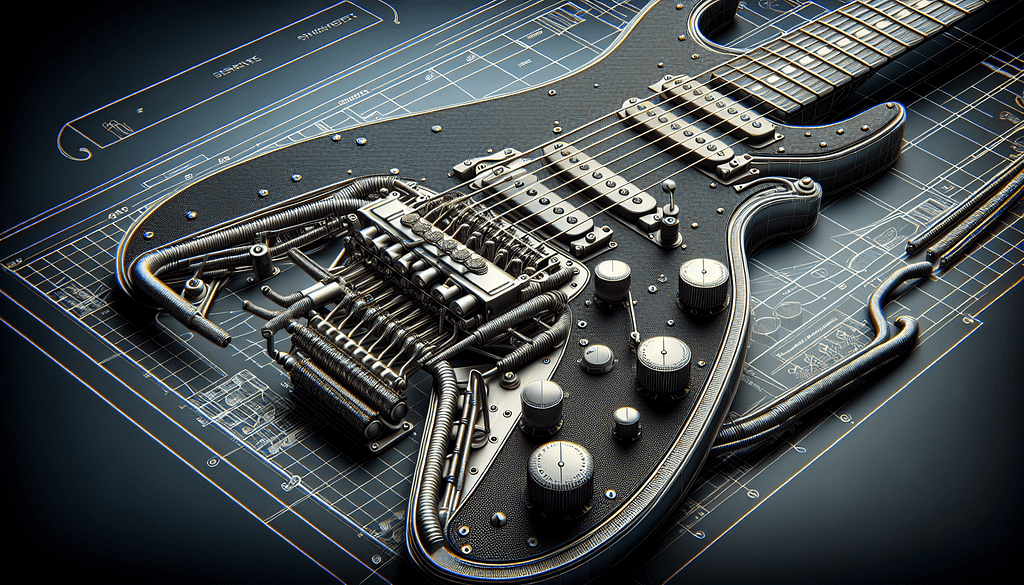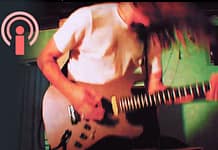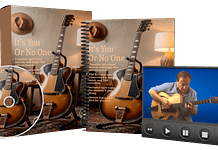This post may contain affiliate links. As an Amazon associate, Google associate as well as associate for other programs, Guitar & Music Institute may earn commissions from qualifying purchases.
In “Mastering the Art of Power Chords,” dive into the foundational techniques that have shaped countless iconic rock anthems. Power chords are a must-know for any aspiring guitarist; you’ll discover what they are, how they work, and why they’re so pivotal in creating that deep, resonant sound that shakes arenas. By the end of this article, you’ll be well on your way to hitting those power chords with confidence and flair. Have you ever wondered how rock and metal guitarists produce those powerful, resonant sounds that get your adrenaline pumping? If you’ve been playing the guitar for a while or if you’re a novice seeking to delve deeper into the realms of rock, grunge, or metal, then you’re in the right place. This article will guide you through mastering the art of power chords and the fundamental techniques that can elevate your guitar-playing skills.
Mastering the Art of Power Chords
Power chords are an essential part of any guitarist’s toolkit, especially if you’re interested in playing rock, punk, metal, or even pop music. Known for their depth and full-bodied sound, power chords form the backbone of many famous riffs and songs.
What Are Power Chords?
Power chords are simplified chords that consist of just two notes—the root note and the fifth. This simplicity yields a sound that’s both powerful and versatile, making it a favorite among guitarists. Unlike more complex chords, power chords don’t include the third note, which means they’re neither major nor minor, thus providing a neutral, robust sound.
Why Learn Power Chords?
Understanding and mastering power chords can open up a world of possibilities for your guitar playing. Here’s why they’re so crucial:
- Versatility: Since they aren’t major or minor, they fit seamlessly into various musical contexts.
- Simplicity: They’re easier to play compared to full chords, making them ideal for beginners.
- Sound: The resonance and depth they add to music are unmatched.
Ready to dive in? Let’s break down the components and learn how you can wield the power of these chords.
The Anatomy of a Power Chord
Understanding what makes a power chord will help you implement them effectively in your playing. In their most basic form, power chords are composed of two notes:
- Root Note: The note that shapes the harmony.
- Fifth Note: A perfect fifth interval from the root.
Basic Power Chord Shapes
There are a few basic shapes that you can move up and down the neck of your guitar:
- Two-String Power Chord (5-chord)
| Root Note | Perfect 5th |
|---|---|
| E (7th fret, A (5th) string) | B (9th fret, D (4th) string) |
| A (5th fret, E (6th) string) | E (7th fret, A (5th) string) |
| G (3rd fret, E (6th) string) | D (5th fret, A (5th) string) |
- Three-String Power Chord
This shape adds the octave note for extra thickness.
| Root Note | Perfect 5th | Octave |
|---|---|---|
| E (7th fret, A string) | B (9th fret, D string) | E (9th fret, G string) |
| A (5th fret, E string) | E (7th fret, A string) | A (7th fret, D string) |
| G (3rd fret, E string) | D (5th fret, A string) | G (5th fret, D string) |
How to Play Power Chords
To play a power chord, follow these steps:
- Place Your Index Finger on the root note.
- Place Your Ring Finger on the fifth.
- (Optional) Place Your Pinky on the octave.
Here’s how to perform a two-string power chord:
- Place your index finger on the 5th fret of the E string (A note)
- Place your ring finger on the 7th fret of the A string (E note)
- Strum only these two strings while ensuring adjacent strings are muted.
For a three-string power chord, add your pinky on the 7th fret of the D string (A note).

Tips for Perfecting Your Power Chords
Like any technique, power chords require practice and attention to detail. Here are some tips to help you master them:
Finger Placement and Hand Position
- Use the Tips of Your Fingers: Ensure you’re pressing the strings with the tips of your fingers to allow for a clean sound.
- Proper Thumb Placement: Place your thumb in the middle of the neck to provide stability and leverage.
- Check for Muting: Ensure adjacent strings are muted to avoid unwanted noise.
Practice with Metronome
Incorporate a metronome into your practice to develop timing and rhythm. Start slowly and gradually increase the tempo as you become more comfortable.
Play Along with Songs
Choose songs that predominantly use power chords. Playing along with tracks will improve your timing, strumming patterns, and confidence.
Use Different Rhythms and Strumming Patterns
Experimenting with different rhythms and strumming patterns will add variety to your playing and help you develop a unique style.
Power Chords in Popular Music
Power chords are used extensively across various genres. Below are a few iconic songs that utilize power chords to create memorable riffs and progressions.
| Song | Band | Chord Progression |
|---|---|---|
| “Smells Like Teen Spirit” | Nirvana | F-B♭-A♭-D♭ |
| “Smoke on the Water” | Deep Purple | G-B♭-C-G-B♭-D♭-C-G-B♭-C-B♭-C-C |
| “Eye of the Tiger” | Survivor | C5-D#5-F5-C5-D#5-F5-G5 |
Breakdown of “Smells Like Teen Spirit” by Nirvana
The opening riff of this classic song serves as a great example for practicing power chords:
- Start with an F power chord (1st fret, E string)
- Move to a B♭ (1st fret, A string)
- Move to an A♭ (4th fret, E string)
- Finally, move to a D♭ (4th fret, A string)
Work on transitioning smoothly between these chords for an authentic sound.
Experiment with Famous Riffs
Challenge yourself by learning famous riffs that use power chords. Not only does this improve your technique, but it also makes practice more engaging.

Power Chords and Alternate Tunings
Alternative tunings can add a new dimension to your guitar playing. Power chords fit well within various tuning setups, each adding a distinctive flavor to your sound.
Drop D Tuning
Drop D tuning allows for easier power chord shapes, and it sounds heavier and fuller, perfect for rock and metal. To tune to Drop D:
- Lower your low E string to D.
Now, you can play power chords by barring the low E, A, and D strings, making transitions and chord combinations quicker and simpler.
D Standard Tuning
In D Standard tuning, every string is tuned down a whole step, which thickens the guitar’s tone. To tune to D Standard:
- E String to D
- A String to G
- D String to C
- G String to F
- B String to A
- E String to D
Power chords follow the same shapes but are noticeably deeper and more resonant.
Techniques to Enrich Power Chords
Mastering power chords involves more than just playing the basic shapes. Adding various techniques can enhance your playing and create a more dynamic sound.
Muting
Palm muting is a technique used to create a “chugging” sound, especially prevalent in metal. Lightly rest your palm on the strings near the bridge while strumming.
Slides
Sliding between power chords adds a fluid, continuous motion to your playing. For example, slide from an A5 to D5 by maintaining the chord shape while moving up the neck.
Bends
Though bending is less common for power chords due to their simplicity, incorporating bends on the higher notes can add a unique edge.
Harmonics
Pinch harmonics with power chords create piercing, high-pitched tones popular in metal. Practice this by striking the string and lightly touching it with your thumb shortly after the pick.
Expanding Beyond Basic Power Chords
Once you’re comfortable with basic power chords, you might want to explore more complex variations. These can include adding notes or incorporating different intervals.
Add 9 Power Chords
Adding the ninth interval to your power chords can create a more interesting harmonic texture. To play an add 9 power chord, include the ninth note along with the root and fifth.
| Chord Type | Finger Placement |
|---|---|
| G5add9 | G (3rd fret, E string), D (5th fret, A string), A (7th fret, D string) |
Inverted Power Chords
Inverting power chords by placing the fifth in the bass can provide a different sound texture.
Power Chords and Scales
Understanding scales can help you transition between power chords more effectively. Familiarize yourself with the major and minor pentatonic scales, which are commonly used.
| Scale | Notes |
|---|---|
| A Minor Pentatonic | A, C, D, E, G |
| E Major Pentatonic | E, F♯, G♯, B, C♯ |
Practicing these scales will help you navigate the fretboard and enrich your playing.
Using Scales for Transitions
For instance, you can use the A minor pentatonic scale to move between A5, D5, and E5 power chords by playing notes within the scale as passing tones.
Recording and Performance Tips
Power chords can shine not only in practice but also in recordings and live performances. Here are a few tips to consider:
Layering Chords
In recording sessions, layer multiple tracks of power chords over each other, using different guitars, effects, and amplifiers. This creates a fuller, more nuanced sound.
Amplifier Settings
Experiment with your amplifier settings to find the perfect tone for your power chords. Increase the gain and bass for a heavier sound and tweak the mids and treble to suit your style.
Effects
Use effects pedals like distortion, overdrive, and reverb to enhance your power chords. Experiment with various combinations to achieve your desired sound.
Final Thoughts
Mastering the art of power chords is a journey that will enrich your guitar playing, expand your musical vocabulary, and open new doors to creative expression. Embrace the simplicity and power of these chords, experiment with various techniques and tunings, and you’ll find yourself producing music that resonates with both you and your audience.
Happy playing!
This post may contain affiliate links. As an Amazon associate, Google associate as well as associate for other programs, Guitar & Music Institute may earn commissions from qualifying purchases.



















